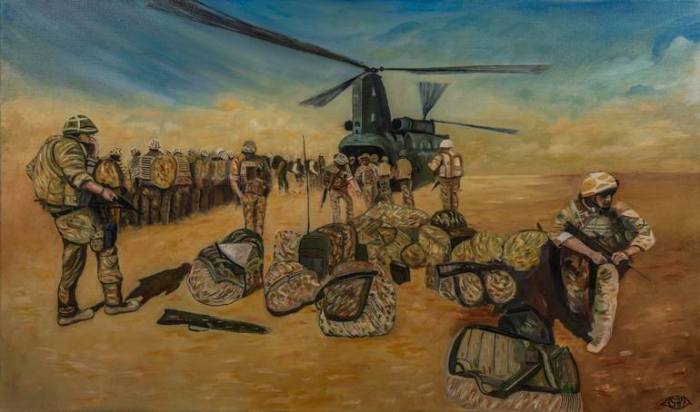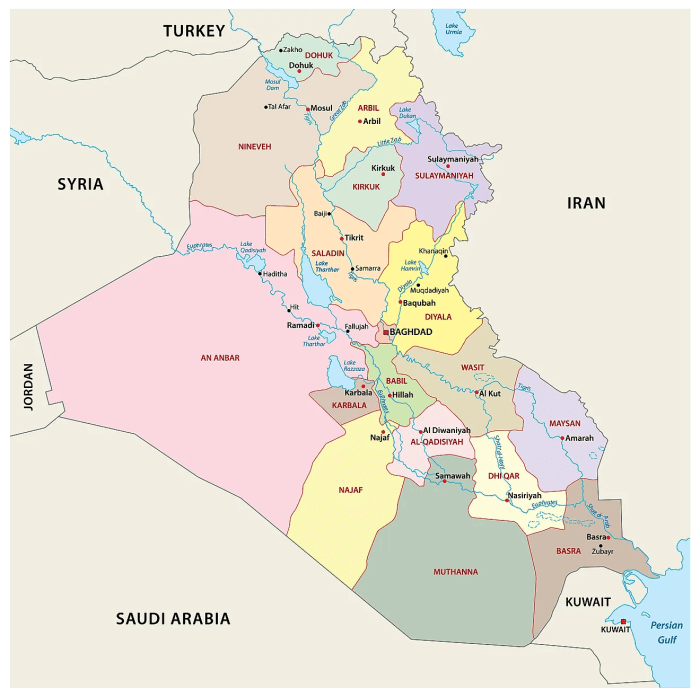Easy Drawing of Iraq and Kuwait A Beginners Guide
Symbolic Representation
Easy drawing of iraq and kuwait – This section explores various symbolic representations of Iraq and Kuwait using simple shapes, aiming to capture their distinct identities and shared history. These designs utilize basic geometric forms to convey complex cultural and geographical aspects. The use of simple shapes allows for easy reproduction and understanding, making them suitable for diverse applications.
Three distinct symbolic representations of Iraq and Kuwait, utilizing only simple shapes, are presented below. Each design incorporates specific shapes to represent key aspects of each nation’s identity, emphasizing their unique characteristics while acknowledging their shared geographical proximity.
Symbolic Representation of Iraq
A crescent moon overlaid on a square represents Iraq. The crescent moon symbolizes Islam, a significant aspect of Iraqi culture and identity. The square represents the stability and grounded nature of the Iraqi people and their rich history. The combination suggests a nation rooted in tradition yet embracing its faith.
Symbolic Representation of Kuwait
A dhow (traditional sailboat) within a circle represents Kuwait. The dhow symbolizes Kuwait’s historical maritime significance and its connection to the Persian Gulf. The circle represents unity and completeness, reflecting the nation’s cohesion and its role as a significant player in regional affairs.
Symbolic Representation of Iraq and Kuwait Together
Two interconnected semicircles, one blue and one green, forming a complete circle represent the shared geography and history of Iraq and Kuwait. The blue semicircle symbolizes Iraq, alluding to the Tigris and Euphrates rivers, while the green semicircle represents Kuwait, reflecting its arid landscape and connection to the fertile crescent. The interlocking semicircles illustrate their shared history and interconnectedness.
Logo Representing Shared History and Geography, Easy drawing of iraq and kuwait
A logo representing the shared history and geography of Iraq and Kuwait can be designed using a simple color palette and shapes. A stylized map of the region, using two shades of brown to represent the land, could be incorporated. A single blue line could symbolize the shared waterway of the Persian Gulf, connecting the two landmasses. This design would visually communicate the geographical proximity and shared history of the two nations.
The choice of brown reflects the desert landscape, and blue reflects the importance of the shared waterway.
Visual Representation of a Key Cultural Element from Each Country
A visual representation of a key cultural element from each country can be achieved using basic drawing techniques.
Visual Representation of Iraqi Cultural Element
A simple depiction of a Mesopotamian ziggurat can represent Iraq’s ancient civilization. The ziggurat can be depicted as a stepped pyramid, utilizing simple lines and shading to create a three-dimensional effect. This design reflects Iraq’s rich history and its ancient architectural achievements.
Visual Representation of Kuwaiti Cultural Element
A stylized image of a falcon, a national symbol of Kuwait, can represent its cultural heritage. The falcon can be drawn using simple lines and shapes, focusing on its powerful form and sharp features. This symbol represents the Kuwaiti values of strength, precision, and independence.
Illustrative Techniques for Beginners

Creating a simple yet informative drawing of Iraq and Kuwait requires understanding basic illustrative techniques. This section details methods for representing geographical features using basic shapes, adding depth through shading, and establishing scale and perspective. These techniques are accessible to beginners and allow for the creation of a recognizable map of the region.
Employing basic shapes to represent complex geographical features simplifies the drawing process while maintaining accuracy. The irregular coastlines of Iraq and Kuwait, for example, can be approximated using a combination of curves and straight lines. The relatively flat terrain of much of the region can be represented with simple rectangles and squares, while the more mountainous areas of northeastern Iraq can be depicted using triangles and irregular polygons.
By carefully combining these basic shapes, a recognizable representation of the region’s geography can be achieved. Remember that simplification is key at this stage; strive for representation rather than exact replication.
Basic Shape Application in Depicting Iraqi and Kuwaiti Geography
Utilizing fundamental geometric shapes provides a foundational approach to illustrating the geographical features of Iraq and Kuwait. The Persian Gulf’s coastal regions can be effectively represented by curved lines and irregular polygons, reflecting their natural contours. Similarly, the relatively flat plains of southern Iraq and Kuwait are easily depicted using rectangles, offering a straightforward visual representation of the landscape’s expanse.
Okay, so you’re looking at easy ways to draw Iraq and Kuwait, right? Simplifying those maps can be tricky, but think about it like simplifying any shape. You might find it helpful to look at other examples of easy black and white drawings, like this guide for a black and white longhorn drawing easy , to get a feel for basic shading and linework.
Applying those same principles of simplification and bold lines to the maps of Iraq and Kuwait will make them much more manageable.
The Tigris and Euphrates rivers, crucial waterways, can be represented by elongated, slightly curving parallel lines. In contrast, the more elevated northeastern regions of Iraq, characterized by mountainous terrain, are best represented through the use of irregular triangles and polygons, effectively conveying the uneven topography. This approach simplifies complex geographical details, making them easily understandable for a beginner.
Shading and Depth Techniques
Adding shading is crucial for creating depth and dimension in a drawing. Simple hatching (parallel lines) or cross-hatching (intersecting lines) can be used to indicate shadows and variations in elevation. The closer the lines are together, the darker the area appears. For instance, darker shading could be used to represent the marshlands of southern Iraq, while lighter shading could represent the desert regions of western Iraq and Kuwait.
Gradual shading transitions can be employed to show subtle changes in elevation, creating a sense of three-dimensionality. A lighter tone can be used for the elevated areas, while darker tones can represent the lowlands or depressions. This method effectively differentiates between various geographical features.
Establishing Scale and Perspective
Establishing scale and perspective in a simple drawing of Iraq and Kuwait is vital for conveying the relative sizes and locations of geographical features. A simple method is to use a consistent scale throughout the drawing. For instance, one centimeter on the drawing could represent a specific number of kilometers in reality. This consistency ensures that the relative sizes of Iraq and Kuwait, as well as their internal geographical features, are accurately reflected.
While a true perspective drawing is complex, a simple technique like using a slightly wider horizon line to represent the Persian Gulf creates a basic sense of depth. The placement of geographical features relative to this horizon line further reinforces the spatial relationship between them. This approach helps beginners convey a sense of scale without requiring advanced drawing techniques.
Step-by-Step Drawing Guide: Easy Drawing Of Iraq And Kuwait

This section provides a simplified, step-by-step approach to drawing maps and scenes representative of Iraq and Kuwait, suitable for children and beginners. The instructions emphasize basic shapes and forms to achieve recognizable representations of the geographical features and cultural elements of the region.
Drawing a Simple Map of Iraq and Kuwait
This exercise focuses on creating a simplified, child-friendly map of Iraq and Kuwait, highlighting their relative positions and shapes. The goal is not geographical precision, but rather a basic understanding of the location and general form of these countries.
- Begin by drawing a large, slightly irregular rectangle to represent Iraq. The rectangle should be wider than it is tall, with a slightly curved or indented eastern border.
- Next, draw a smaller, roughly rectangular shape adjacent to the lower-left corner of Iraq. This represents Kuwait. Ensure it’s significantly smaller than Iraq and connected to it.
- Add a simple wavy line along the lower border of both shapes to represent the Persian Gulf.
- Optional: Add small dots or simple symbols to represent major cities like Baghdad (in Iraq) and Kuwait City (in Kuwait). Label them if desired, using simple lettering.
The resulting image should be a basic, easily recognizable map illustrating the relative sizes and locations of Iraq and Kuwait. The shapes can be slightly irregular, reflecting the simplified nature of the exercise.
Drawing a Desert Landscape
This guide Artikels the creation of a simple desert scene evocative of the landscapes found in Iraq and Kuwait. The focus is on conveying the essential features of the desert environment using basic shapes and shading.
- Start with a horizon line drawn across the lower portion of the page. This will separate the sky from the land.
- Draw several undulating lines above the horizon line to represent sand dunes. Use varying heights and curves to add visual interest.
- Add small, scattered shrubs or tufts of grass using simple, irregular shapes. These should be sparse, reflecting the typical desert vegetation.
- Use shading to create depth and texture. Darker shades can be used in the valleys between dunes and in the shadows cast by the shrubs. Lighter shades represent the sunlit areas.
- Optional: Add a simple sun in the sky to enhance the desert atmosphere.
The final drawing should depict a recognizable desert scene, characterized by sand dunes, sparse vegetation, and a sense of vastness and openness. The use of shading is crucial to add depth and realism.
Drawing a Simplified Traditional Market Scene
This section guides the creation of a simplified drawing depicting a traditional market scene common to Iraq and Kuwait. The emphasis is on conveying the atmosphere and key elements of such a market using simple shapes and forms.
- Draw several interconnected rectangular or square shapes to represent the stalls of a market. These can be arranged in a slightly irregular pattern to add realism.
- Add simple shapes above the stalls to represent awnings or roofs providing shade. These could be flat, curved, or triangular.
- Draw small, simple figures within or near the stalls to represent people shopping or selling goods. These figures can be highly stylized and simple.
- Add a few simple objects to represent the goods being sold. These could be bags, baskets, or other simple shapes, representing dates, spices, or textiles, characteristic of the region.
- Optional: Add a background element, such as a simple wall or a suggestion of buildings in the distance, to provide context.
The final drawing should represent a bustling, though simplified, market scene, conveying the essence of a traditional Iraqi or Kuwaiti marketplace through the arrangement of stalls, figures, and goods. The focus should be on conveying the atmosphere rather than detailed realism.
FAQs
What materials do I need to draw Iraq and Kuwait?
You’ll only need basic drawing materials: paper, pencils (a regular pencil and possibly a darker one for shading), an eraser, and optionally, colored pencils or crayons.
Can I use this guide to draw specific buildings in Iraq or Kuwait?
While the guide focuses on simplified representations, the techniques can be adapted to draw specific buildings. Research images of the buildings you want to draw for reference.
How can I make my drawings more realistic?
Practice shading and adding details. Observe reference images to understand light and shadow and how they affect shapes and forms. Experiment with different pencil pressures.
Is this guide suitable for all ages?
Yes, the step-by-step instructions and simple techniques make this guide suitable for children and adults alike.



